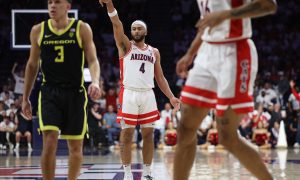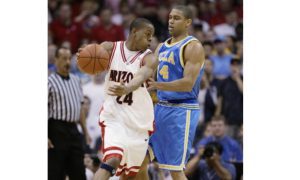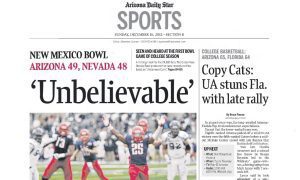Remember the days when lightning-quick 5’11” guard Kenny Lofton manned the post in a 1-3-1 zone defense for Lute Olson?
“Anybody who is constantly there like he is, is really aggravating to the big players,” Olson said about that alignment with Lofton in February 1987. “They’re used to someone their size and quickness, and all of a sudden, here’s this waterbug. A lot of his steals come from the side or behind when they catch the ball down there.”
Instead of always trying to front the opposing point guard throughout the possession, Lofton was switching between 6-foot-11 centers and 6-foot-9 power forwards trying to offset their size with his speed. Olson is a Hall of Fame coach for a reason.
This expample shows how unconventional Olson was with his changing defenses, including man-to-man and various matchup zones. He was not a stick-to-one-defense-or-bust coach. Olson sprung surprises, even going to a fullcourt press on occasion.
The aura of Olson hangs over the program of which he made a consistent national title contender. That’s not entirely fair to Sean Miller, who is in his ninth year with three Elite Eight appearances, yet the comparisons continue between his tenure and that of his permanent predecessor Olson.
A recurring topic, especially when Arizona struggles on defense defending a penetrating guard or wing, is Miller’s reluctance to use a zone defense similar to how Olson utilized his multiple defenses when necessary.
Miller’s use of the pack line man-to-man defense is his identity. The idea is to keep defenders back inside the imaginary pack line about a foot within the 3-point line in which they try to deny dribble penetration. The hope is to clog the inside and protect the paint by keeping the ball out of the post with constant pressure on the ball.
If a team has excellent on-the-ball defenders, who can defend multiple positions, and alert and quick-footed interior players, the defense works its best.
If the guards are not strong against dribble penetration and the interior players are not quick enough to help close out the lane, the pack line is not as effective.
Miller has made it known this week he wants to play Dusan Ristic more along with fellow 7-footer Deandre Ayton because of Ristic’s offensive production and their ability to draw fouls. That might start tonight when Arizona hosts Cal State Long Beach.
Ristic is not known for his defense, which adversely affects the pack line’s principle of choking the post and being active against dribble penetration or when an interior player has the ball on the post.
Miller commented while in the Bahamas that he might use a zone defense after playing Ristic only 11 minutes against an SMU team that had a smaller lineup.
“It was just a really tough matchup for him and I feel bad because Dusan is playing the best I think he’s ever played,” Miller told Bruce Pascoe of The Arizona Daily Star. ““As a coach you have to figure out how to put your best players on the court, and there are times with Deandre and him together we may have to look at some zone.
“I know that’s something we haven’t done a whole lot in my time but in our current situation, just big picture, Dusan is such a force in the low post and he’s such a good scorer that it’s difficult to rationalize that he’s not able to play him because they went small.”
Will Miller finally give it a shot with Ristic and Ayton manning the baseline and post while in a 2-3 zone? Will that take the pressure off Parker Jackson-Cartwright, Allonzo Trier and Arizona’s developing players on the perimeter?
Arizona ranks No. 199 in the nation in scoring defense (74.8 points a game) and No. 212 in defensive efficiency — not what anybody would expect from a Miller-coached team.
Former Cal coach Cuonzo Martin, now at Missouri, was strictly a man-to-man defensive coach until last weekend when the Tigers played a 2-3 zone with 12 minutes left in the game against St. John’s at the Advocare Invitational at Lake Buena Vista, Fla.
Martin said after the game he is usually hesitant to play zone defense but thought it was the right call to finally implement it after seeing how the Red Storm (with former Arizona guard Justin Simon) was scoring through the lane.
Missouri emerged with a 90-82 win after trailing by eight when he started the zone.
“It was more to do with stopping the penetration,” Martin said of the 2-3 zone. “What happens is, and I think that’s why you see the scores so high in the NBA, if you can make plays off the dribble and make free throws and shots, it’s extremely tough to guard. I don’t care who you are, unless you are trapping, trying to get the ball out of that person’s hands. …
“I just felt like for us, the zone was more to stopping the bleeding as opposed to getting in foul trouble.”
Olson said in the accompanying video that he was strictly a man-to-man defensive coach in high school but he changed his philosophy once he got to the college level because the use of zone defenses were more widespread. He also believed his team was better prepared by practicing multiple defenses if a situation dictated the use of a zone defense — to help stop penetration all the way to the basket, for instance.
“It was important for us to put one (matchup zone) in so that our players had day-to-day work against the matchup zone,” Olson said about his time at Iowa, where he began primarily as a man-to-man defensive coach. “So we used it to begin with as a means of preparing our teams how to go about playing against it. But then as we worked with it more and more in practice situations we found that it can be a very effective defense.
“We have gone now to the use of the man-to-man, we use the matchup, we also use the 1-3-1 zone, so we have become much more of a multiple defensive team now than what we were in our early years,” Olson said in the video that was taped in the late 1980’s when Arizona advanced to its first Final Four.
Coaching is all about adjustments. Olson did that shifting away from primarily man-to-man defenses. Martin made the game-saving adjustment against St. John’s by going to a 2-3 zone at a crucial time.
If Arizona continues to have defensive breakdowns like it had against North Carolina State, SMU and Purdue last week, how long can Miller go before he makes adjustments?
FOLLOW @JAVIERJMORALES ON TWITTER!
ALLSPORTSTUCSON.com publisher, writer and editor Javier Morales is a former Arizona Press Club award winner. He is a former Arizona Daily Star beat reporter for the Arizona basketball team, including when the Wildcats won the 1996-97 NCAA title. He has also written articles for CollegeAD.com, Bleacher Report, Lindy’s Sports, TucsonCitizen.com, The Arizona Republic, Sporting News and Baseball America, among many other publications. He has also authored the book “The Highest Form of Living”, which is available at Amazon.





















